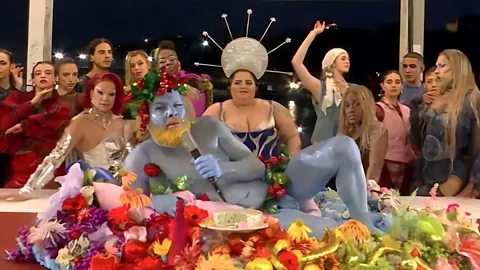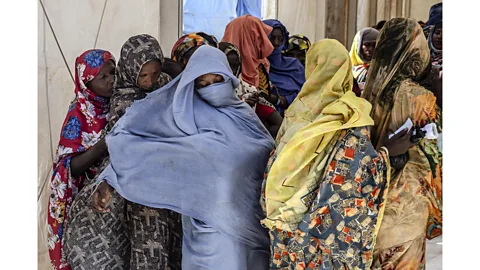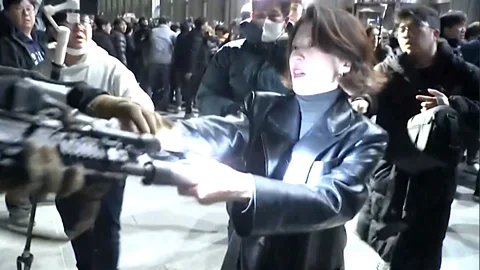 Getty Images
Getty ImagesFrom the awe-inspiring photo of a surfer in Tahiti to the iconic shot of US President-elect Trump captured after an assassination attempt, these are 12 of the most eye-catching images of the last year.
 Reuters
Reuters1. Solar eclipse, Bloomington, Indiana, US
An airplane bisects a total solar eclipse above Bloomington, Indiana, on 8 April – its extended contrails silhouetted against a shimmering corona. It is not, of course, the first time that the paths of an airplane, the moon, the sun, and Earth have crossed. In January 1925, an American Navy airship, the USS Los Angeles, was loaded with 500lb (227kg) of telescopes and the minds of seven scientists to observe as close as possible a much anticipated solar eclipse whose path passed directly over New York City, making it, according to some, the most watched eclipse in history. Not on board, but watching carefully from behind his easel back on Earth, was the US painter Howard Russell Butler, who captured the event as the third panel of a triptych of stunning eclipses (1918, 1923, and 1925) that he hoped would inspire schoolchildren.
 Thomas Jolly
Thomas Jolly2. Olympics Opening Ceremony, Paris, France
Knowing your art history can save you considerable stress and heartache. That, at least, was one of the lessons learned from the controversy surrounding a photo of a decadent tableau taken during the Olympics opening ceremony. The image, which features an oversized table-setting of a naked figure lying decadently on a platter, surrounded by drag queens and a seductive singer sitting in a fruit bowl, was mistaken for a satire of The Last Supper by some Christian and conservative critics, who condemned the piece as distastefully sacrilegious. Apologising for the confusion, the Paris 2024 organising committee clarified that the tableau was not intended to recall Leonardo da Vinci’s masterpiece at all, but to summon instead the Greek God Dionysus, recalling the contours instead of a later painting by Jan van Bijlert, The Feast of the Gods, 1635.
 Getty Images
Getty Images3. Transit Centre, Renk, South Sudan
Sudanese refugees wait their turn for assistance in a crowded queue at a Transit Centre in Renk, South Sudan in February. By the beginning of 2024, more than half-a-million people had fled the fighting between the Sudanese Army and the paramilitary Rapid Support Forces, pushing resources in South Sudan to breaking point. The joyful fluidity of colourful fabrics and rhythm of rich patterns contrasts starkly with the sobriety of the migrants’ situation. The photo’s intensity recalls the rhythm and texture of abstract works by the celebrated Sudanese artist and film-maker Hussein Shariffe, whose poetic paintings blurred the line between the colours we see and those we feel.
 AFP Photo/ Center for Volcanology and Geological Hazard Mitigation
AFP Photo/ Center for Volcanology and Geological Hazard Mitigation4. Volcano erupting, Indonesia
Images of Indonesia’s powerful volcano Mount Ruang, which erupted many times in April, hurling hot lava and smouldering columns of ash into the sky, were as mesmerising as they were menacing. The fearsome force of volcanic activity has fascinated image-makers for millennia and a photo of the sublime outpouring of incandescent tephra, vaporised pumice, and molten ore into the atmosphere was uncannily in accord with the violent vision of British Romantic artist John Martin. Two centuries ago, he reimagined the eruption of Mount Vesuvius in 79 AD for his apocalyptic painting The Destruction of Pompeii and Herculaneum, 1822.
 AP
AP5. US President-elect Donald Trump, Pennsylvania, US
Some photos choreograph themselves, prescient of their own enduring iconicity. The hoisting of the US flag over Iwo Jima, for instance, or the raising of fists in the Black Power salute by US athletes during the medal ceremony at the 1968 Summer Olympics in Mexico City, spring to mind. Echoing elements of both of those two milestones of image-making, the photo of a defiant, fist-pumping Donald Trump, clambering to his feet with his face bespeckled with blood after a would-be assassin pierced his right ear with a bullet at a campaign rally in July, while a disbalanced Stars and Stripes tilts behind him, had many wondering if this was the moment he won the election.
 Getty Images
Getty Images6. Palestinian refugee camp, southern Gaza
Two Palestinian girls, preparing for Ramadan, light lanterns to decorate crowded refugee tents in southern Gaza on 29 February. The lanterns’ soft light contrasts starkly with the eerie gloam of an uncertain sunset flickering in the distance. By summer, 90% of Gazans (roughly two million people) will have been displaced by war. The enchanting act of lantern lighting echoes a famous scene from art history – John Singer Sargent’s charming portrait of his friend’s daughters in a twilit garden in south-west England, Carnation, Lily, Lily, Rose, painted patiently over a span of many months when the light was just right for a few fleeting moments each evening in autumn 1885. All that is missing is the green grass and the wildflowers and an abiding sense of peace.
 Getty Images
Getty Images7. Olympics men’s surfing heats, Tahiti
The inspiriting image of Brazil’s Gabriel Medina soaring skyward after tackling a huge wave off the French Polynesian Island of Tahiti in round three of the men’s surfing heats on 29 July instantly went viral. Medina’s seemingly effortless levitation recalls countless religious representations of mystical ascension in western Art, from Giotto to Rembrandt, Il Garofalo to Salvador Dalí. What seals the surprising synchronicity of athletic elevation with spiritual ascent is Medina’s raised right arm and the cool thrust of his index finger, pointing precisely to where his body and soul appear to be heading.
 AP
AP8. Flooding, Valencia, Spain
A woman in Valencia, Spain gazes from her balcony on 30 October at the flooded neighbourhood below, as swept-up vehicles smash into one another, like a stampede of steel bulls smashing through the streets. A meteorological phenomenon known as a DANA (Depresión Aislada en Niveles Altos), or “cold drop”, struck Valencia a day earlier, triggering unprecedented rainfall. In just eight hours, 500mm (20in) fell, devastating the region. The vertiginous vantage of the Valencian woman, through whose eyes we watch the world crumple and twist, recalls the rumpled perspective of Italian Cubist Carlo Carra’s 1912 painting, Simultaneità, La donna al balcone. (Concurrency, woman at the balcony).
 Getty Images
Getty Images9. Billie Eilish, New York City, US
At a listening party for the release of her album Hit Me Hard and Soft in New York City in May, US singer songwriter Billie Eilish appears to dissolve into a dream of smoke-hung light as her body is at once amplified and vapourised into a hefty, if intangible, silhouette. The dissolution of self into resplendent mist calls to mind the evaporative visions of British painter JMW Turner, whose complex painting Light and Colour (Goethe’s Theory) – the Morning after the Deluge, 1843, imagines a seemingly unfathomable moment of sublime illumination that sets the stage for every scintillating shade of existence that follows.
 Getty Images
Getty Images10. Toppling of statue, Syria
In a gesture of profound disdain, a circle of citizens in Syria stomps its shoes on the head of a toppled statue of former President Hafez al-Assad on 9 December. Following the collapse of Syria’s Baath regime and the fleeing of the Assad family from the country, Syrians were seen tearing down countless effigies of the father of ousted President Bashar al-Assad in cities across the country. There is, of course, a kind of communal catharsis in the shared jubilation of de-pedestaling statues of rejected rulers, as we see in William Walcutt’s 1857 painting of a circle of ecstatic New Yorkers pulling down British sculptor Joseph Wilton’s statue of King George III in July 1776, following a rousing reading of the freshly adopted Declaration of Independence.
 Bess Adler
Bess Adler11. Ballerinas, New York City, US
In April, more than 350 dancers gathered to set the Guinness World Record for the most ballerinas ever to pose simultaneously en pointe. A photo of many of the participants excitedly preparing for the competition captured the elegance and energy of the momentous occasion. The claustrophobic crush of so many young women would doubtless have appealed to the French Impressionist artist Edgar Degas, who, it seems, did not merely relish the sight of skilful dancers, whom he called his “little monkey girls”, practising and performing, but the anguished sound of their joints “cracking”. “I have perhaps too often”, he confessed to the painter Pierre-Georges Jeanniot, “considered woman as an animal”.
 OhmyTV via AP
OhmyTV via AP12. National Assembly, Seoul, South Korea
A South Korean woman fearlessly seizes the barrel of a soldier’s loaded rifle. Captured soon after President Yoon Suk Yeol declared martial law, the image shows Ahn Gwi-ryeong, 35, a spokesperson for the opposition Democratic party, grappling with heavily armed soldiers who were ordered to prevent lawmakers from gathering. “My only thought”, Ahn later said of the confrontation, “was that I just needed to stop them. I pushed them away, shook them off, and did everything I could”. Ahn’s unflinching determination and even the shimmer of steely light off her clothes calls to mind British artist John Gilbert’s stirring 19th-Century watercolour portrait of Joan of Arc.
* The numbers in this piece do not represent ranking, but are intended to make the separate entries as clear as possible.

